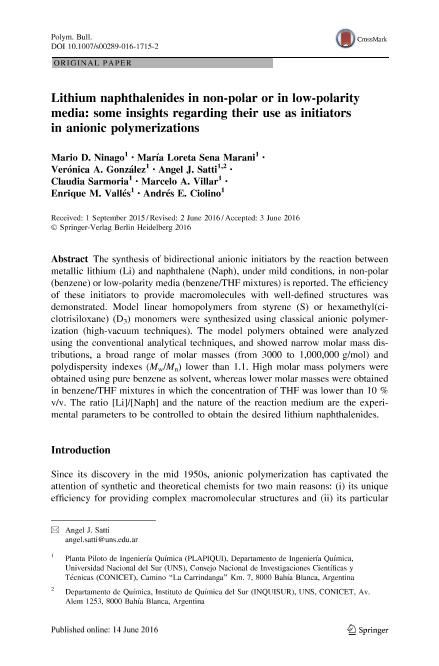Artículo
Lithium naphthalenides in non-polar or in low polarity media: Some insights regarding their use as initiators in anionic polymerizations
Ninago, Mario Daniel ; Sena Marani, María Loreta
; Sena Marani, María Loreta ; Gonzalez, Verónica Alejandra
; Gonzalez, Verónica Alejandra ; Satti, Angel Jose
; Satti, Angel Jose ; Sarmoria, Claudia
; Sarmoria, Claudia ; Villar, Marcelo Armando
; Villar, Marcelo Armando ; Valles, Enrique Marcelo
; Valles, Enrique Marcelo ; Ciolino, Andrés Eduardo
; Ciolino, Andrés Eduardo
 ; Sena Marani, María Loreta
; Sena Marani, María Loreta ; Gonzalez, Verónica Alejandra
; Gonzalez, Verónica Alejandra ; Satti, Angel Jose
; Satti, Angel Jose ; Sarmoria, Claudia
; Sarmoria, Claudia ; Villar, Marcelo Armando
; Villar, Marcelo Armando ; Valles, Enrique Marcelo
; Valles, Enrique Marcelo ; Ciolino, Andrés Eduardo
; Ciolino, Andrés Eduardo
Fecha de publicación:
14/06/2016
Editorial:
Springer Verlag Berlín
Revista:
Polymer Bulletin
ISSN:
0170-0839
e-ISSN:
1436-2449
Idioma:
Inglés
Tipo de recurso:
Artículo publicado
Clasificación temática:
Resumen
The synthesis of bidirectional anionic initiators by the reaction between metallic lithium (Li) and naphthalene (Naph), under mild conditions, in non-polar(benzene) or low-polarity media (benzene/THF mixtures) is reported. The efficiency of these initiators to provide macromolecules with well-defined structures was demonstrated. Model linear homopolymers from styrene (S) or hexamethyl(ciclotrisiloxane)(D3) monomers were synthesized using classical anionic polymerization (high-vacuum techniques). The model polymers obtained were analyzed using the conventional analytical techniques, and showed narrow molar mass distributions, a broad range of molar masses (from 3000 to 1,000,000 g/mol) and polydispersity indexes (Mw/Mn) lower than 1.1. High molar mass polymers were obtained using pure benzene as solvent, where as lower molar masses were obtained in benzene/THF mixtures in which the concentration of THF was lower than 10 %v/v. The ratio [Li]/[Naph] and the nature of the reaction medium are the experimental parameters to be controlled to obtain the desired lithium naphthalenides.
Palabras clave:
Lithium Naphtaleinides Iniciator
,
Anionic Polymerization
,
Polystyrene
Archivos asociados
Licencia
Identificadores
Colecciones
Articulos(INQUISUR)
Articulos de INST.DE QUIMICA DEL SUR
Articulos de INST.DE QUIMICA DEL SUR
Articulos(PLAPIQUI)
Articulos de PLANTA PILOTO DE INGENIERIA QUIMICA (I)
Articulos de PLANTA PILOTO DE INGENIERIA QUIMICA (I)
Citación
Ninago, Mario Daniel; Sena Marani, María Loreta; Gonzalez, Verónica Alejandra; Satti, Angel Jose; Sarmoria, Claudia; et al.; Lithium naphthalenides in non-polar or in low polarity media: Some insights regarding their use as initiators in anionic polymerizations; Springer Verlag Berlín; Polymer Bulletin; 74; 2; 14-6-2016; 307-323
Compartir
Altmétricas



